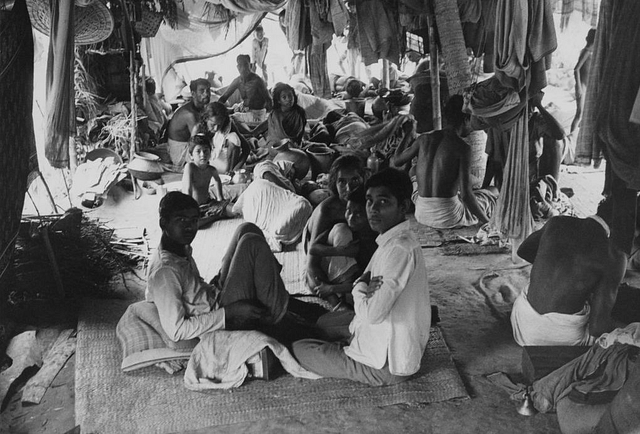
The Conspiracy Of Silence And Danger Of Denial
In his book, Tathagata Roy lists the many reasons and puerile, fallacious and shallow arguments that have been employed to avoid speaking about the atrocities suffered by Bengali Hindus.
The mass-scale persecution of Bengali Hindus in East Pakistan and then Bangladesh, the arson and loot of their properties, and the rapes, murders and forcible conversions to Islam they have been subjected to has perhaps no parallel in history. Because this has been happening since 1947 and continues until today. Leave apart condemnation, there is not even a token acknowledgement of the terrible sufferings borne by millions of Bengali Hindus from Bangladesh.
Barely any books have been written, save for a seminal one — My People, Uprooted: The Exodus Of Hindus From East Pakistan and Bangladesh by Tathagata Roy, the former state president of the Bharatiya Janata Party in Bengal, who is currently the Governor of Meghalaya — and few, if any, talk about it. There is, says Roy, a strange conspiracy of silence in the name of ‘secularism’ and ‘communal harmony’. In his book, Roy lists the many reasons and puerile, fallacious and shallow arguments that have been employed to avoid speaking about the atrocities suffered by Bengali Hindus in East Pakistan and Bangladesh.
The common argument, and justification for, covering up the persecution of Bengali Hindus resulting in their continuing exodus from Bangladesh is that speaking or writing about it would cause disaffection among Hindus and Muslims in Bengal and other parts of the country and would affect communal harmony. Hence, ‘secularism’ demands that not only the persecution of Bengali Hindus be hushed up, but a blind eye turned to their continuing sufferings and they be left to fend for themselves.
In his book, Roy writes: “Nowhere else in the world, arguably, has a set of people’s sense of history been made to become so warped through systematic brainwashing, nowhere else do people imagine themselves to be politically conscious and yet live in a virtual world of political make-believe made of a glorious past, a frog-in-the-well present, and foreseeably, little future, as among the Hindus of West Bengal. This warp manifests itself in a strange pretension to being ‘world citizens’ not bound by the mundane bonds of nationalism and religion. The Hindus of West Bengal are more aware of the problems of the Chechens of Chechnya, and the late Che Guevara’s in Bolivia and probably the penguins of Tasmania than they are of those of their hapless cousins in Bangladesh”.
The Left eco-system in Bengal worked diligently to cover up the persecution of Bengali Hindus in East Pakistan and Bangladesh. Roy writes: “there was apprehension among the Leftists that hearing about Muslim atrocities in East Bengal (and then East Pakistan and Bangladesh) might unify the Hindus in West Bengal in the name of Hinduism and might cause them to stray from the path of Leftism. There was, therefore, a conscious effort to conceal history, misinterpret it, dilute it, and use every trick in the book to make sure it was forgotten”.
Among the many specious justifications made to conceal this history of persecution, killings, rapes, forcible conversions and banishment of Hindu Bengalis from eastern Bengal is the ‘forgive and forget’ one. The proponents of this view feel there would be no purpose served by raking up the past, especially since doing so may drive Hindus in Bengal to seek revenge. Some, say Roy, even attempt to justify the atrocities suffered by the Hindus by holding that Muslim peasants had earlier been exploited by Hindu zamindars and money-lenders. Others blame the British for creating the communal divide, the Marxists view it erroneously from the ‘class struggle’ prism, while many even deny the persecution completely.
But, argues Roy, telling the truth does not create disaffection. Rather, concealing it does, especially in the long run. “It is totally dishonest, stupid and even downright dangerous to pretend that the persecution of Bengali Hindus never happened. It is important to study history, and it is short-sighted and stupid and obnoxious and ill-motivated to try to obliterate history,” he says. “The study of history has nothing to do with forgiving and forgetting, but only with finding out what had happened, why it had happened, and putting it down on paper,” he adds. It is important to write correct history to learn lessons for the future. Roy puts the counter-argument that it is not necessary to whitewash the past in order to secure the future.
Roy, in his book, goes back to Bengali society before the 1905 partition of Bengal, traces the politics between 1905 and 1947, and then documents in detail the persecution of Bengali Hindus in eastern Bengal from the pre-Partition (pre-1947) era through the genocides of the 1950s, the holocaust of 1971 and the gentle and not-so-gentle squeezing out of Bengali Hindus from Bangladesh after 1971 (the formation of Bangladesh). He estimates that while more than eight million Bengali Hindus have fled East Pakistan and Bangladesh from 1947 to 2000, a couple of million have been killed and forcibly converted to Islam.
Roy issues a chilling warning about not learning from history. History, if not learnt from, “might repeat itself and some future generation of Hindus of West Bengal at some date in future may find themselves in the same plight (as Bengali Hindus of East Pakistan and Bangladesh), with nowhere further west to go”. This is a warning that Bengali Hindus can ignore only at their own peril.